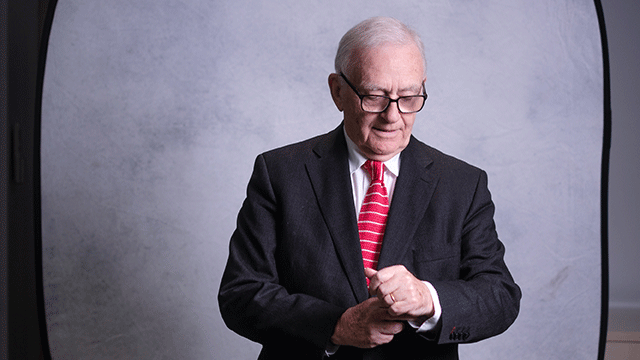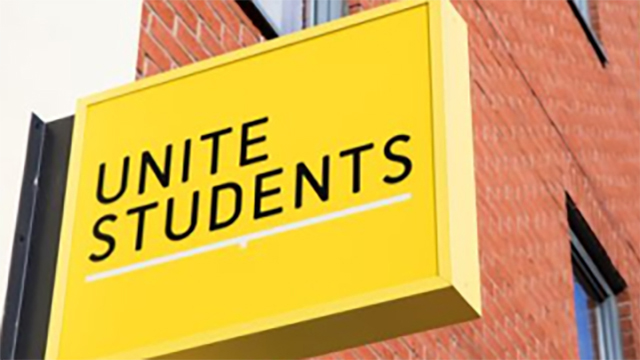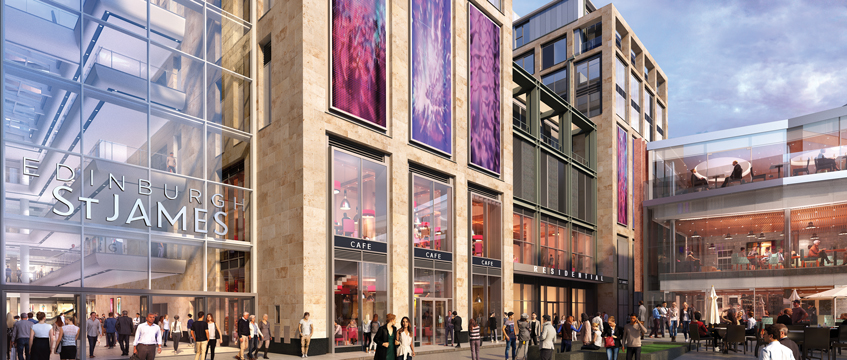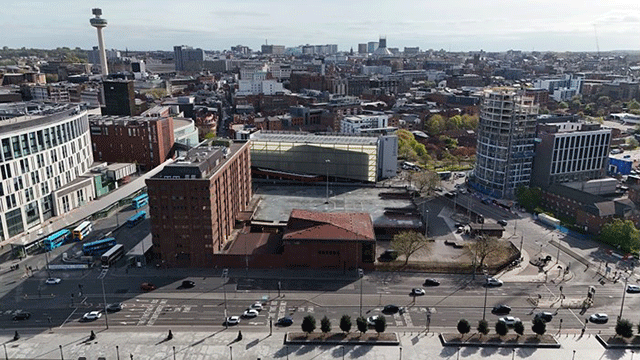Tower cranes and excavators have occupied around seven acres of land in the heart of Edinburgh for nearly four years – and counting. But finally, the project that has long promised to transform Edinburgh’s skyline is starting to take shape.
More than £850m has been invested into the mixed-use Edinburgh St James development – majority-owned by Dutch fund manager APG, alongside a 25% stake held by Nuveen Real Estate’s UK shopping centre fund – with the end-goal of reaching more than £1bn in investment value.
Now two-thirds of the way to completion, Edinburgh St James, which is a 1.7m sq ft, 115-unit project anchored by a controversial “ribbon” W Hotel – will have taken around 15 years to materialise when it fully launches in 2021.
In addition to its catchment, the development will make a play for the 4.6m tourists visiting the city per year, which in turn is forecasted to grow by more than 3.5% annually.
Retail circuit
“The city needs retail,” says Martin Perry, director of development for Edinburgh St James. “This is a world heritage site – it’s crammed with listed buildings, which means you can’t do anything with them. Although there is huge demand to be in Edinburgh, it is not easy to find space to trade from.”
To deviate from the more inward-focused, conventional shopping centre model, Nuveen aims to create a “retail circuit” that weaves in its surrounding shopping thoroughfares, while layering leisure and residential on top.
It will include a cinema, food hall, three-storey apartment block, an aparthotel, three levels of basement parking, and three public squares. Additionally, there are plans to devise an online marketplace app, with scope to extend its reach beyond the scheme to products stocked at nearby shops, such as those on Princes Street.
“We are trying to produce something that does not damage, but enhances the city’s retail offer,” says Perry.
Re-leasing the pressure
There is less than a year to go until the first retailers move into the five-storey mall aspect, which is anchored by a 165,000 sq ft John Lewis. However, the retail and leisure galleria is currently 60% let; a further 10% is under offer, with another 15% in legals.
“We certainly were not expecting it to be anywhere near as tough to lease as it has been,” admits Perry. “But [the scheme] is still great because it is the right size for the market, and there are still a lot of people that are interested in taking up space. We are fortunate to have investors that have been prepared and very flexible in [adapting] to the market.”
To attract tenants, the team has been offering agreements including turnover-based terms, indexed leases, cap and collar contracts, and lease conversions.
“It’s a two-way street,” says Chris Pyne, director of retail for the UK at Nuveen. “We don’t want to lease things for a long time given that fashion is, by definition, transient – [we] don’t want to lock things up for a long time as that may come back to bite us.”
On completion, it will be the only rack-rented development in the market. By avoiding a “cookie-cutter approach” to leasing, Perry says the team has largely managed to sidestep difficulties that other investors – particularly the major retail REITs – might face.
Edinburgh St James indeed stands out as one of a mere handful of retail developments that are expected to complete within the next few years; other billion-pound projects such as Westfield Croydon, owned by Hammerson and Unibail-Rodamco-Westfield, and Hammerson’s Brent Cross extension have been put on ice by their landlords.
“What we have been particularly fortunate in is, it was never a particularly big project from a retail perspective,” says Perry. “We’re not Brent Cross or Westfield, trying to build around 320 retail units. If you break it down and account for double or triple units, [we] probably end up with around 70, which is not very many.”
Soldiering on
When the 850,000 sq ft retail element launches next year, it will equal 21% of the city’s total retail offer. Is there any regret when it comes to offering such a large retail component? “Probably a little bit,” admits Perry, highlighting the amount of mezzanine space that it needed to fill – an error that can be widely observed across other developments.
“We are getting through it,” he adds. “Competitive socialising was not out there as a sector in 2007, so we are fortunate that it can take up some of that space.”
Perry is also realistic about the churn it could see from its retailers, given the precedent set by other launches. “We were involved in Westfield Stratford; one of the things we learnt about dealing with it is that the huge amount of churn of retailers in the first year of trading (from 2011) was much faster than, say, the Bullring when it opened (from 2004). So we anticipate we will be churning retailers even before they open on this project.”
Consequently, working out the scheme’s precise investment value has become rather more complicated. Its mixed-use nature, however, bestows clear advantages: after all, the separate hotel or car park aspects could always be split off for sale.
“Nobody has gone into this other than with a long-term view,” says Perry. “The decisions that have been taken have not been based on maximising profitability, but on doing the right thing for the future, and how it will allow us to change and vary [according to] what could be on the horizon.”
Edinburgh St James – the players
- Stakeholders: APG, Nuveen, Queensberry Properties
- Residential developer: Native Land
- Main contractor: Laing O’Rourke
- Letting agents: Culverwell, Davis Coffer Lyons, P-Three, CWM
- Concept architect: Allan Murray and Associates
- Architect for W hotel: Jestico + Whiles
Edinburgh St James: a timeline
2006
Nuveen, then known as Henderson Global Investors, acquires the St James shopping centre and the offices above it. At the time the centre, which originally opened in 1972, was half-empty; the offices above it were derelict
2009
Plans to redevelop the centre are unanimously approved
2014
Compulsory purchase orders are made, to enable the land and property acquisitions required for development to begin in 2016
2015
Detailed consent is submitted to, and approved by, Edinburgh Council. John Lewis signs for 165,000 sq ft as the scheme’s anchor tenant, and continues to trade from the site while other retailers either close or relocate
2016
CPOs are obtained following a public inquiry. Perry recalls ultimately acquiring “250-odd interests” to free up space for the development. Demolition begins. Starwood Hotels & Resorts Worldwide agrees to operate the 12-storey “ribbon” hotel, through its W Hotels brand. More retailers sign for space including Next, which agrees 50,000 sq ft, and Everyman Cinemas, for a 17,300 sq ft, five-screen multiplex. APG buys a 75% stake in the retail and leisure aspects of the development; Nuveen, then known as TH Real Estate, retains 25% on behalf of its UK Shopping Centre Fund. Native Land is named as the residential development manager, partnering with resi backer Queensberry Properties (a jv between Cruden Homes and Buccleuch Property)
2018
Construction begins after nearly 18 months of extensive demolition and excavation works
2019
More lettings are agreed, with Inditex’s Zara, Bershka, Stradivarius and Pull & Bear brands. A tram extension at nearby Picardy Place is approved by councillors; the line is expected to be operational in 2023. The structure is due to complete in December
2020
The 850,000 sq ft retail element is expected to launch, as well as 30 restaurants, cafés and bars. The residential aspect will also open, consisting of 152 flats
2021
Both the cinema and hotel aspect, featuring Scotland’s first five-star W Hotel, will respectively open. The W Hotel will offer 244 bedrooms, and luxury aparthotel brand Roomzzz will provide 75 bedrooms
To send feedback, e-mail pui-guan.man@egi.co.uk or tweet @PuiGuanM or @estatesgazette











